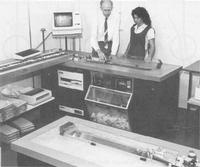


Chapter 5
I 1788 - State Of The Art In Textile Technology
II Australian Textiles - The Early Days
III Australian Textiles - The 20th Century
i Technology and Development
ii Australian Wool Textile Research
IV Australian Textiles - To Date
V Acknowledgements
References
Index
Search
Help
Contact us

Australian Wool Textile Research (continued)
This development -the 'Twinsplicer' -was commercialized by Savio S.p.A. a major manufacturer of yarn-winding machines in which the splicer is incorporated.Not content with this, the researchers then went on to make an improvement to the pneumatic splicing machines. Studies of air flow in such devices led to the realization that application of heat would increase the trapping and cohesion of fibres caused by the blast of air. This simple idea[54] has also been commercialized, this time in conjunction with Schlafhorst A.G., another major winding-machine maker.
While the 1970s saw the increased adoption of sale of raw wool by sample plus objective measurement of diameter, yield and vegetable, research work continued to develop instruments to measure other properties. In the sale-by-sample system, three of the leading characteristics of the raw wool which buyers still subjectively assess by examination of the sample are (i) the length of the staples; (ii) tenderness (the presence or otherwise of weak spots in the fibres which may lead to fibre breakage in processing); and colour. The research led to the development[55] in the early 1980s of two automated instruments for the measurement of staple length, staple strength and the position of break (Fig. 26) at the rate of 60 staples per hour.

Using prototypes of this instrumentation, international industry trials were held to demonstrate that additional measurements could be profitably used in wool marketing and processing. The main conclusions[56] of these trials were:
- Additional measurements made predictions of processing behaviour even more reliable. The additional measurements help processors to guarantee the qualities of the wool in later processing stages. Features such as fibre length in the top and the 'romaine' or tearing expected in the combing phase could be predicted accurately. Previously, these features were subjectively estimated and since processors faced big losses if the wool did not perform to expectations, buyers tended to be very conservative in their appraisals to avoid claims against them.
- The additional measurements should spur the introduction of innovations aimed at improving productivity. By having more detailed specifications of the raw material, a comber, for instance, who produces large quantities of a standard type of top may be able to increase the production rate when processing wools of higher staple strength.
- Additional measurements should reduce costs in preparing wool blends. Wools are always blended at the start of processing. When used in conjunction with price data, raw-wool measurements could be a powerful tool for minimising the total cost of the blend components; one can arrive at a least-cost solution to specific requirements.
These measurements are now (1986) being offered as additional options to wool buyers. Samples are still on show and will be retained until there is a consensus within the wool industry that the objective measurements suffice in predicting processing and end-product yield and performance. There is no doubt, however, that not long into the third century of this nation's existence wool will be sold by computer, without the buyers having seen their purchase.
Organisations in Australian Science at Work - CSIRO
 |
Australian Academy of Technological Sciences and Engineering |  |
© 1988 Print Edition pages 296 - 298, Online Edition 2000
Published by Australian Science and Technology Heritage Centre, using the Web Academic Resource Publisher
http://www.austehc.unimelb.edu.au/tia/298.html